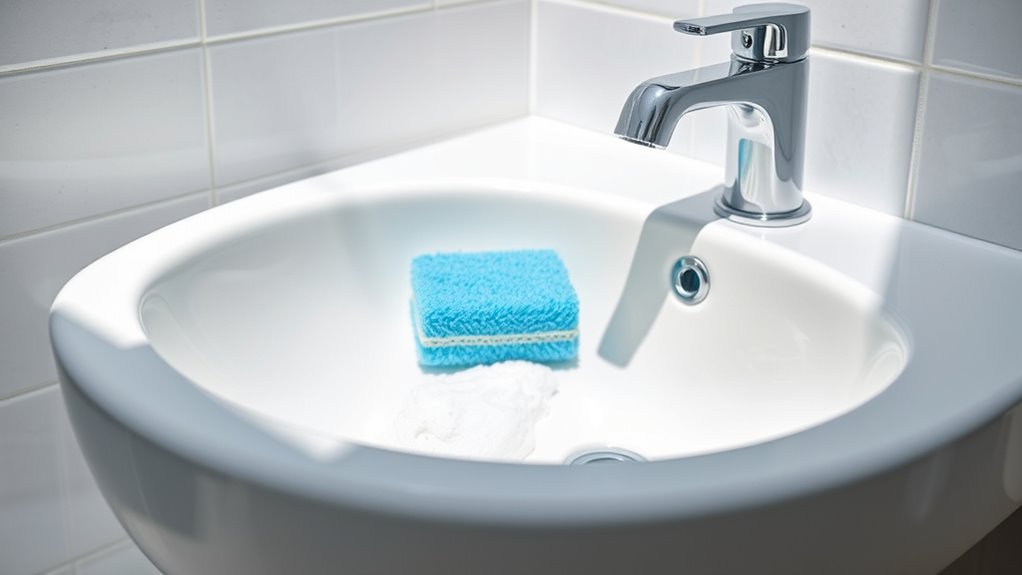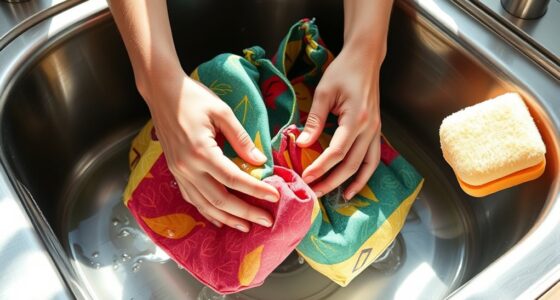To clean a ceramic sink, start by rinsing it thoroughly with warm water to remove loose debris. Sprinkle baking soda over the surface, especially around the drain and grout lines, then scrub gently with a soft brush or toothbrush. For mineral deposits, spray a mixture of equal parts vinegar and water, wait a few minutes, then scrub and rinse. To keep your sink spotless, incorporate regular maintenance tips and explore detailed steps that follow.
Key Takeaways
- Rinse the sink with warm water to remove loose debris before cleaning.
- Sprinkle baking soda over the surface and scrub with a soft brush or toothbrush.
- Use a vinegar-water solution to target hard water stains and mineral deposits.
- Rinse thoroughly and dry with a soft cloth to prevent water spots and streaks.
- Regularly clean with gentle, non-abrasive cleaners to maintain the ceramic’s shine.

Have you ever wondered how to keep your ceramic sink spotless and looking new? It’s easier than you might think, especially if you know the right techniques to tackle common issues like tile grout buildup and hard water stains. These are the main culprits that can make your sink look dull and unclean over time, but with a little effort, you can restore its shine and freshness.
Start by rinsing your sink thoroughly with warm water to remove loose debris. Then, sprinkle baking soda generously over the entire surface. Baking soda acts as a gentle abrasive that lifts dirt and grime without scratching the ceramic. Pay special attention to areas around the drain and edges where tile grout, soap scum, and mineral deposits tend to accumulate. If you notice any tile grout lines that are dirty or discolored, use a soft brush or an old toothbrush dipped in a mixture of baking soda and water to scrub them gently. This helps break down the grout and remove any mold or soap scum that might be hiding there.
Rinse with warm water, then scrub grout lines gently with baking soda and a soft brush.
To target hard water stains, create a cleaning solution using equal parts white vinegar and water. Vinegar is highly effective at dissolving mineral deposits caused by hard water. Spray this mixture over the stained areas and let it sit for about 10 minutes. The acidity of vinegar loosens the mineral buildup, making it easier to wipe away. After the waiting period, scrub the stains with a soft cloth or sponge, paying attention to the edges and corners. For stubborn stains, you can sprinkle some additional baking soda on top of the vinegar solution and scrub gently. The fizzing action helps lift off more mineral deposits and soap scum. Be careful not to use abrasive pads or steel wool, as they can scratch the ceramic surface.
Once you’ve scrubbed all affected areas, rinse thoroughly with warm water to wash away residue. Wiping the sink dry with a soft towel or microfiber cloth helps prevent water spots and streaks. Regularly diversify your cleaning methods and incorporate gentle, non-abrasive cleaners to maintain the ceramic’s luster. To keep your ceramic sink sparkling, repeat this cleaning process weekly, especially if you live in an area with hard water. Regular maintenance prevents the buildup of tile grout grime and hard water stains, so your sink always looks its best.
Frequently Asked Questions
Can I Use Bleach to Disinfect My Ceramic Sink?
Yes, you can use bleach to disinfect your ceramic sink, but do so carefully. Bleach use helps eliminate germs, but it can also cause surface discoloration if left on too long or used in high concentrations. Always dilute bleach properly, use it sparingly, and rinse thoroughly afterward. Avoid prolonged contact to prevent damage and maintain your sink’s appearance while ensuring it’s disinfected effectively.
How Often Should I Deep Clean My Ceramic Sink?
Think of your ceramic sink as a garden that needs regular tending. You should deep clean it once a month to keep it sparkling and prevent buildup. For maintenance tips, rinse after each use, avoid harsh chemicals, and wipe it dry to prevent stains. Consistent cleaning frequency keeps your sink looking new and functioning well, so make it part of your routine and enjoy a spotless, fresh space every day.
Are Natural Cleaning Solutions Effective for Ceramic Sinks?
Yes, natural cleaning solutions are effective for ceramic sinks. They’re environmentally friendly and provide chemical-free cleaning, making them a safe choice for your home. You can use ingredients like baking soda, white vinegar, or lemon juice to remove stains and buildup. Simply apply, scrub gently, and rinse. These solutions work well to keep your ceramic sink spotless without exposing yourself or the environment to harsh chemicals.
What Should I Do About Persistent Hard Water Stains?
Imagine a mirror reflecting your efforts—persistent hard water stains can be stubborn, but you can tackle them. Use a mixture of vinegar and baking soda for hard water removal, applying it directly to the stains. Let it sit, then scrub gently. To prevent future stains, wipe your sink regularly and dry it after use. Consistent stain prevention keeps your ceramic sink shining and free of unwanted marks.
Is It Safe to Use Abrasive Scrubbers on Ceramic Surfaces?
You should avoid using abrasive scrubbers on ceramic surfaces because they can cause surface damage. While abrasive cleaners might seem effective, they can scratch or dull the finish over time. Instead, opt for soft sponges or cloths and mild cleaners. This approach keeps your ceramic sink looking new and prevents unnecessary surface damage, ensuring it stays clean and shiny without risking permanent harm.
Conclusion
Now, imagine your ceramic sink sparkling under bright, clean light, its smooth surface gleaming like a mirror. With just a gentle scrub and a splash of water, you’ve banished grime and stains, revealing a pristine, inviting space. Every time you glance at your freshly cleaned sink, you’ll feel a sense of accomplishment, knowing you’ve restored its beauty. Keep up this simple routine, and your sink will continue to shine, welcoming you with every use.









